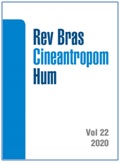The range of motion of the back squat exercise affects absolute volume load without changing the rating of perceived exertion
DOI:
https://doi.org/10.1590/1980-0037.2020v22e58196Abstract
The range of motion (ROM) may affect the external maximal load during back squat (BS) exercise. The correct ROM manipulation can be useful as an exercise load manipulation strategy, changing the volume load during a resistance training session. The aim of this study was to evaluate the acute effects of ROM on relative load, absolute load and the rating of perceived exertion (RPE) during partial and full BS exercise with adjusted loads. Fifteen male individuals (age: 26.5±4.5 years; height: 173±6 cm; body mass: 80.6 ± 8.8 kg; resistance training experience 5±3 years) participated in this study. The experimental procedure was conducted in two sessions. In the first session, brief familiarization and a 10-repetition maximal test (10-RM) was performed for partial (PBS) and full BS exercise (FBS) with 30-min of rest interval. During the second session, all subjects performed 1 set of 10-RM in both conditions (partial and full ROM), and relative load, absolute load, and RPE were evaluated. A paired t-test was used to compare means. The results showed higher values for PBS when compared to FE exercise: relative load (PBS: 1.14±0.24xBW vs. FBS: 0.87±0.24xBW; P<0.001), and absolute load (PBS: 925±249 kg x FBS: 708±232 kg, P<0.001). Similar RPE was observed between conditions (PBS: 8.6±1.3 IEP x FBS: 8.5±1.0 IEP, P=0.855). It was concluded that PBS allowed higher relative load and absolute load during 10RM, without effects on RPE.
References
Marchetti PH, Gomes WA, Luz Junior DA, Giampaoli B, Amorim MA, Bastos HL, et al. Aspectos neuromecânicos do exercício agachamento. Rev Cent Pesqui Av Qual Vida 2013;5(2): 1-16.
Marchetti PH, Calheiros Neto RB, Charro MA. Biomecânica Aplicada: Uma abordagem para o treinamento de força. São Paulo: Phorte; 2019.
Contreras B, Vigotsky AD, Schoenfeld BJ, Beardsley C, Cronin J. A comparison of gluteus maximus, biceps femoris, and vastus lateralis EMG amplitude in the parallel, full, and front squat variations in resistance trained females. J Appl Biomech 2016;32(1):16-22.
Paoli A, Marcolin G, Petrone N. The effect of stance width on the electromyographical activity of eight superficial thigh muscles during back squat with different bar loads. J Strength Cond Res 2009;23(1):246-50.
Escamilla RF, Fleisig GS, Lowry TM, Barretine SW, Andrews JR. A three-dimensional biomechanical analysis of the squat during varying stance widths. Med Sci Sports Exerc 2001;33(6):984-98.
Escamilla RF, Fleisig GS, Zheng N, Lander JE, Barrentine SW, Andrews JR, et al. Effects of technique variations on knee biomechanics during the squat and leg press. Med Sci Sports Exerc 2001:1552-6.
Ninos JC, Irrgang JJ, Burdett R, Weiss JR. Electromyographic analysis of the squat performed in self-selected lower extremity neutral rotation and 30 degrees of lower extremity turn-out from the self-selected neutral position. J Orthop Sports Phys Ther 1997;25:307-15.
Bloomquist K, Langberg H, Karlsen S, Madsgaard S, Boesen M, Raastad T. Effect of range of motion in heavy load squatting on muscle and tendon adaptations. Eur J Appl Physiol 2013;113:2133-42.
Caterisano A, Moss RF, Pellinger TK, Woodruff K, Lewis VC, Booth W. The effect of back squat depht on the EMG activity of 4 superficial hip and thigh muscles. J Strength Cond Res 2002;16:428-32.
Marchetti PH, Silva JJ, Schoenfeld BJ, Nardi PSM, Pecoraro SL, Greve JMDA, et al. Muscle activation differs between three different knee joint-angle positions during a maximal isometric back squat exercise. J Sports Med 2016;2016:1-6.
Silva JJ, Schoenfeld BJ, Marchetti PN, Pecoraro SL, Greve JMDA, Marchetti PH. Muscle activation differs between partial and full back squat exercise with external load equated. J Strength Cond Res 2017;31(6):1688-93.
Ebben WP, Leigh DH. The role of the back squat as a hamstring training stimulus. J Strength Cond Res 2000;22(5):15-7.
Sugisaki N, Kurokawa S, Okada J, Kaneshia H. Difference in the recruitment of hip and knee muscles between back squat and plyometric squat jump. Plos One 2014;9(6):1-9.
Tran QT, Docherty D, Behm D. The effects of varying time under tension and volume load on acute neuromuscular responses. Eur J Appl Physiol 2006;98(4):402-10.
Tiggemann CL, Pinto RS, Kruel LFM. A percepção de esforço no treinamento de força. Rev Bras Med Esporte 2010;16(4):301-9.
Day ML, McGuigan MR, Brice G, Foster C. Monitoring exercise intensity during resistance training using the session RPE scale. J Strength Cond Res 2004;18(2):353-8.
Eng J. Sample Size Estimation: How many individuals should be studied? Radiol 2003;227(2):309-13.
Maulder P, Cronin J. Horizontal and vertical jump assessment: reliability, symmetry, discriminative and predictive ability. Phys Ther Sport 2005;6(2):74-82.
Foster C, Florhaug JA, Franklin J, Gottschall L, Hrovatin LA, Parker S, et al. A new approach to monitoring exercise training. J Strength Cond Res 2001;15(1):109-15.
Bentes CM, Simão R, Bunker T, Rhea MR, Miranda H, Gomes TM, et al. Acute Effects of Dropsets Among Different Resistance Training Methods in Upper Body Performance. J Hum Kinet 2012;34:105-11.
Baechle TR, Earle RW. Fundamentos do treinamento de força e do condicionamento. 3 ed. São Paulo: Manole; 2010.
Rhea MR. Determining the magnitude of treatment effects in strength training research through the use of the effect size. J Strength Cond Res 2004;18(4):918-20.
Zatsiorsky VM, Kraemer WJ. Ciência e prática do treinamento de força. São Paulo: Phorte; 2008.
Robertson DGE, Wilson JJ, St. Pierre TAS. Lower extremity muscle functions during full squats. J Appl Biomech 2008;24:333-9.
Kompf J, Arandjelovic O. Understanding and overcoming the sticking point in resistance exercise. Sports Med 2016;46(6):751-62.
Sweet TW, Foster C, McGuigan MR, Brice G. Quantitation of resistance training using the session rating of perceived exertion method. J Strength Cond Res 2004;18(4):796–802.
Watt B, Grove R. Perceived exertion. Antecedents and applications. Sports Med 1993;15(4):225-41.



